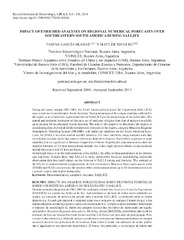Mostrar el registro sencillo del ítem
Impact of enriched analyses on regional numerical forecasts over southeastern South America during SALLJEX
| dc.contributor.author | García Skabar, Yanina | |
| dc.contributor.author | Nicolini, Matilde | |
| dc.date.accessioned | 2017-07-11T11:37:37Z | |
| dc.date.available | 2017-07-11T11:37:37Z | |
| dc.date.issued | 2014 | |
| dc.identifier.issn | 1982-4351 | |
| dc.identifier.uri | http://dx.doi.org/10.1590/0102-778620100248 | |
| dc.identifier.uri | http://hdl.handle.net/20.500.12160/266 | |
| dc.description | Artículo publicado en la Revista Brasileira de Meteorologia, v.29, n.3, 315 - 330, 2014. | es |
| dc.description.abstract | During the warm season 2002-2003, the South American Low-Level Jet Experiment (SALLJEX) was carried out in southeastern South America. Taking advantage of the unique database collected in the region, a set of analyses is generated for the SALLJEX period assimilating all available data. The spatial and temporal resolution of this new set of analyses is higher than that of analyses available up to present for southeastern South America. The aim of this paper is to determine the impact of assimilating data into initial fields on mesoscale forecasts in the region, using the Brazilian Regional Atmospheric Modeling System (BRAMS) with particular emphasis on the South American Low-Level Jet (SALLJ) structure and on rainfall forecasts. For most variables, using analyses with data assimilated as initial fields has positive effects on short term forecast. Such effect is greater in wind variables, but not significant in forecasts longer than 24 hours. In particular, data assimilation does not improve forecasts of 24-hour accumulated rainfall, but it has slight positive effects on accumulated rainfall between 6 and 12 forecast hours... | es |
| dc.language.iso | eng | es |
| dc.publisher | Revista Brasileira de Meteorologia | es |
| dc.subject | DATA ASSIMILATION | es |
| dc.subject | NUMERICAL FORECASTS | es |
| dc.subject | SALLJEX | es |
| dc.title | Impact of enriched analyses on regional numerical forecasts over southeastern South America during SALLJEX | es |
| dc.type | Article | es |
